Menu
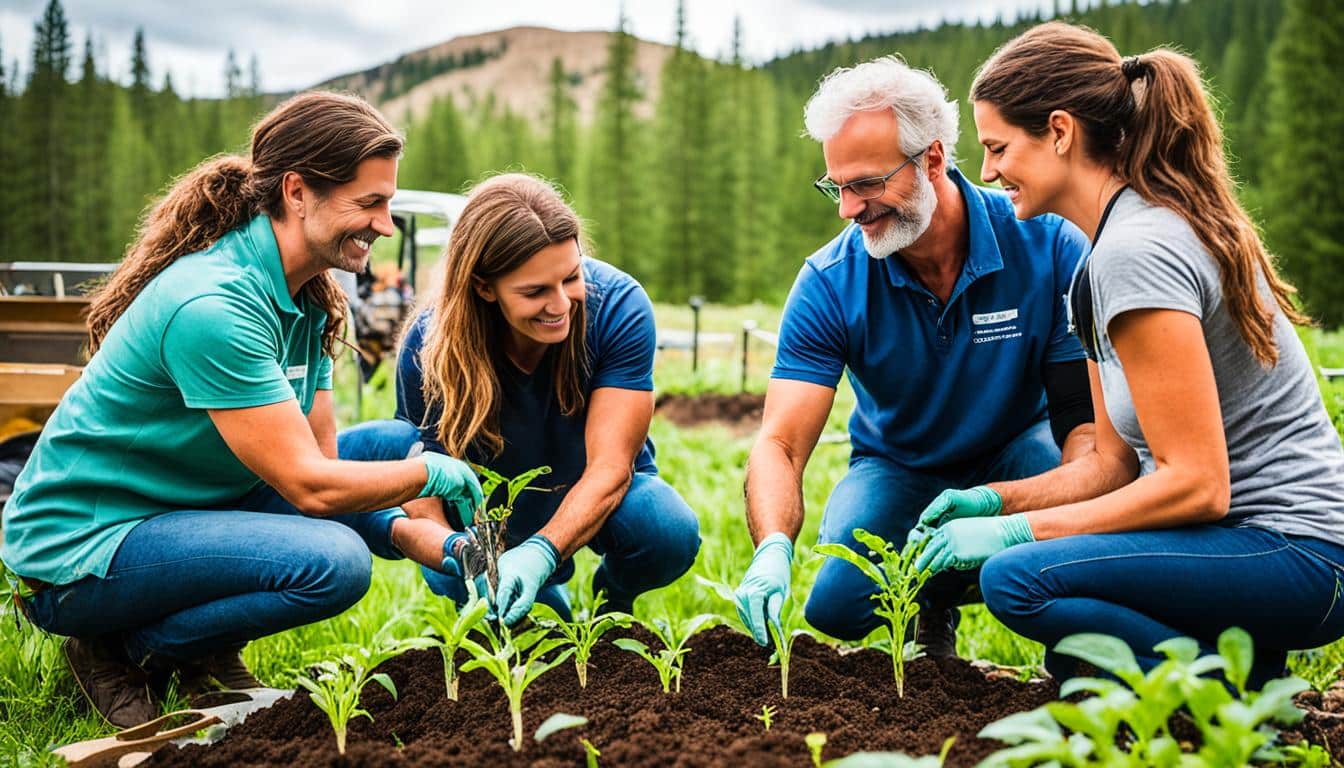
Did you know that agriculture occupies half of the world’s habitable land? This number shows we must farm more responsibly. Agriculture also uses 70% of our freshwater and causes most of the water pollution. This reveals how working together on soil health is vital for a greener future.
Farmers, scientists, and governments are joining forces to boost soil health. Their goal is to keep our soils healthy and make farming more sustainable. A team effort can solve many problems our soil faces today.
Efforts like the one in Andhra Pradesh, India, and the African Landscape Action Plan show promising results. They prove that eco-friendly farming methods can boost yields by 11% and farmers’ incomes by 49%. These successes highlight the importance of working together for a greener, more prosperous farming future.
Soil health is crucial for growing crops sustainably and keeping our planet in balance. Many experts share knowledge about soil health, like Mitch Kezar in his video showing key tests. He also talks with farmers like Tom Fick and Terry Aukes in full-length interviews.
The article focuses on efforts to make the soil healthier. These involve many people working together in partnerships. Their goal is to improve the environment and help farmers use better practices.
Maintaining soil health is key to agriculture and the environment. Experts in videos and discussions highlight the importance of good soil. They explain techniques including bale grazing and cover crop grazing to improve soil.
Presentations by people like Keith Berns show how soil health benefits the economy. The Soil Carbon Cowboys highlight successful initiatives by people like Allen Williams. Such heroes in soil health show the way through their unique practices.
Today, dealing with herbicide-resistant weeds is a big issue. But, communities are coming together to find sustainable weed control methods. They’re reducing the use of harmful soil practices, like over-tilling, to keep the soil healthy.
By growing a variety of plants and adding animals, we can make the soil even better. By doing this, the soil processes nutrients more effectively. It also helps plants grow and supports the life of small organisms in the soil.
Experts have made videos that show how to manage soil by using animals better. They also talk about the importance of microbes in the soil. Knowing the past practices of caring for the soil helps us plan a better future.
| Expert | Key Contributions |
|---|---|
| Dr. David Montgomery | Regenerative agriculture and soil conservation |
| Kent Solberg | Sustainable grazing practices |
| Dr. Michael Lehman | Soil microbial activity research |
| Erin Silva | Cover crop resilience |
| Gabe Brown | Innovative grazing and soil health |
Although we face challenges in soil management, a new way forward is clear. By working together and sharing knowledge, we can build a better agricultural future. This involves improving and preserving our lands and water, ensuring sustainability for generations to come.
Regenerative agriculture aims to create sustainable and strong farming systems. It looks beyond the usual ways of farming. Instead, it focuses on making our soils, natural environments, and farming communities healthier.
Regenerative practices focus on key principles. These are all about improving our soils. One important idea is to always keep the soil covered. This is usually done with green plants. It stops erosion and keeps the soil healthy. It’s vital to have plants with roots that are alive and growing. This helps keep the soil full of life.
It’s also key to avoid tilling too much. One acre of tilling a year can harm the soil’s structure and its tiny helpers, the microbes. Biodiversity is crucial too. Having more plant types creates a place where lots of different tiny creatures can live and work together, like earthworms and beneficial microbes.
Bringing livestock into the picture is critical. Animals help with the soil’s health by moving nutrients around. They also help manage water and nutrients in a more creative way.
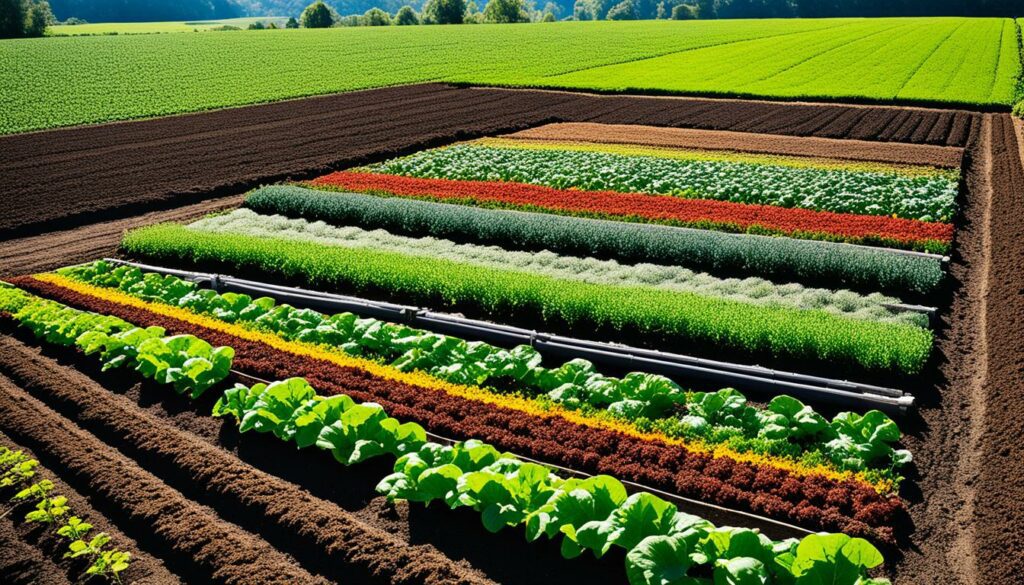
Regenerative agriculture brings many benefits. For instance, healthy soil is dark. This shows it’s full of organic matter and carbon. This makes it great at soaking up water and storing carbon. So, it helps fight climate change.
It also means less soil erosion and better soil structure. This provides the perfect place for plants to grow. It also stops the soil from getting too packed, which can hurt plant roots and their growth.
These practices benefit more than just the land. They also help farming communities do better economically. Farms become more profitable due to lower costs and higher yields. Plus, they become more resilient to bad weather. This happens because they recycle nutrients better and use smart ways to manage pests.
Working together to manage the soil is very important. Farmers, scientists, and leaders must all join forces. Only then can we make real change in our farming methods. This helps keep our land productive for many years to come. It shows how powerful regenerative farming can be.
Collaboration is key to keeping our soils healthy and strong. Farmers, governments, and schools must work together. By doing so, they improve soil health and support sustainable farming and food systems.
Farmers work closely with experts and officials to tackle soil health issues. A report found that many farmers in the Midwest don’t own their land. This shows why partnerships are crucial. For example, in Illinois, Indiana, and Iowa, there are “Conservation Conversations.” These help farmers and landowners not farming work together on soil care.
The Soil Renaissance project is a great example of what teamwork can achieve. In 2017, it got a $10 million grant. Together with other funds, it had nearly $20 million to improve soils across North America. They studied 2,000 soil samples to understand what makes soil healthy.
The Soil Health Partnership (SHP) also shows the power of teaming up. They have over 220 farmers working with them in 16 states. They compare modern soil care to old ways. SHP also teams up with over 120 groups. Together, they provide farmers with the best advice on soil health. This effort helps good soil care spread, making soil stronger for all.
Moreover, the Operational Tillage Information System (OpTIS) shares data on better soil care. More farmers are now using cover crops and reducing how much they plough. This change is thanks to working together.
These success stories highlight the importance of ongoing partnerships. They ensure our soils stay healthy and farming remains sustainable for the future.
The farming world faces a big problem with weeds not responding to herbicides, like Roundup. This means the usual ways to control weeds are not working so well. This challenge is pushing for new and green ways to tackle the issue.

Herbicide-resistant weeds have become a tough hurdle for farmers to overcome. The weed killers they rely on are losing their power, making the fight against weeds harder and more expensive. With the process for approving new chemical solutions lengthy and costly, the need for other methods is urgent.
Regenerative farming offers a complete approach to fighting weed resistance. It suggests using cover crops and natural weed management techniques to reduce the use of harmful chemicals. By working with the land, farmers can find new ways to farm that are better for the earth.
Connecting with other farmers is also key in learning and sharing good weed control methods. This cooperation is vital in tackling weed issues and supporting the environment. The Soil Renaissance project, started in 2013, is living proof of how teaming up can better farm practices, combining efforts from farmers, academics, and officials.
New technologies are also showing up to fight against herbicide-resistant weeds. For example, herbicides made from mint are getting special regulatory treatment, making them a fresh and effective choice. Companies, such as Harpe Bioherbicide, are leading the way in these eco-friendly solutions, showing positive effects in real field trials.
To sum up, green ways of fighting weeds, with a strong focus on looking after the soil, are the answer to the problem. By caring for the earth and using new methods, farmers can enjoy better soil health, which is the key to a thriving future in farming.
Soil quality partnerships are key in restoring soil ecosystems. They promote sustainable ways to take care of our soils. These efforts bring together farmers, scientists, and local people. Together, we can tackle challenges our soils face today.
One big success story is the use of Soil Health Management Systems (SHMS). Seeding these systems raised farm profits by $65 per acre on average for 29 farms. They also cut costs, making corn and soybeans cheaper to grow by $14 and $7 per acre. For other crops, expenses were reduced by $16 per acre.
These systems also boosted crop yields. Most farms saw better corn, soybean, and other crop harvests. Besides making more money, farmers were hit by less soil erosion. They could use their fields earlier in wet years. And the farms were better at withstanding severe weather.
Farmer videos, economic fact sheets, and stories all helped in soil health education. The Soil Health Institute, along with key groups like the Conservation Districts, play a big part. They make sure that learning and sharing information are part of promoting good soil health practices.
Education programmes by groups like OCC and NRCS are really making a difference. They teach people about the best ways to look after soil. And projects such as OACD’s and NRCS’s campaigns are crucial for healing our soil ecosystems.
Cover crop and no-till studies by OSU show real progress. They’re clear steps forward in taking care of our soils. The involvement of groups like the Southern Plains Climate Hub is great. It shows how many different efforts are working to better soil health.
Western Farmers Electric Cooperative’s strong support is clear. They’ve been backing soil health programmes for a while. Efforts like theirs are essential for keeping our farms productive and our soils rich.
Many projects show how working together can make soil healthier and more sustainable. This happens all around the world. Projects in Asia, Africa, and more help not just the soil, but also the plants and animals that live on it.
In India, the Andhra Pradesh Community-Managed Natural Farming project is going strong. It teaches farmers to use fewer chemicals and more natural ways to grow crops. In Africa, the Landscape Action Plan works to fix 100 million hectares of damaged land by 2030. Their efforts are really boosting soil health.
In Australia, the BASE project checks the life in the soil across the country. This is key to planting the right things and making soil better. Over in Malawi, more than 6,000 farmers are learning better farming methods. This is helping to make sure there is enough food for everyone in over 200 villages.
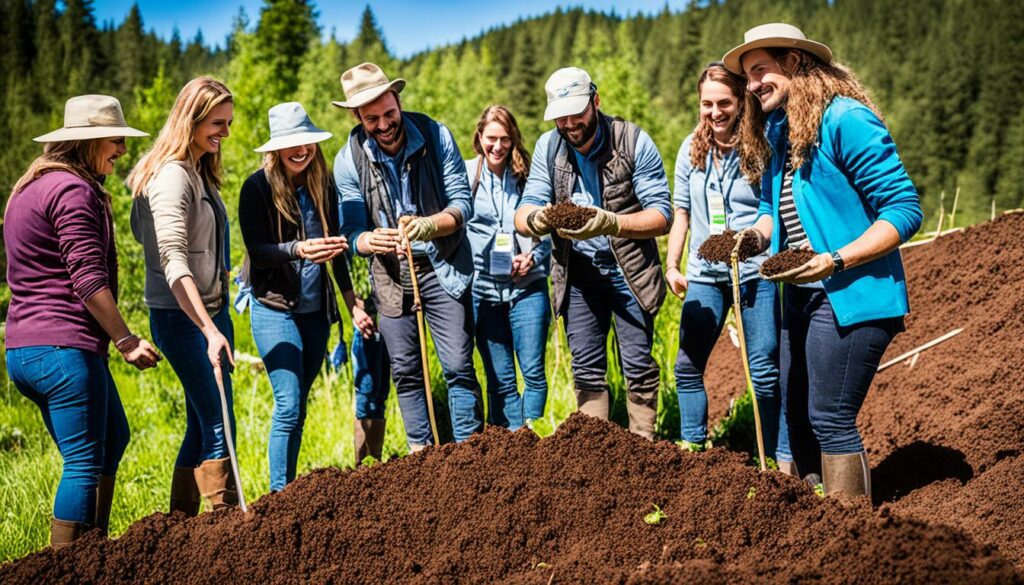
So, what difference are these projects making? Well, since the start of big-scale farming, a lot of carbon has gone into the air. This hurt our planet. But now, thanks to projects like these, we’re getting a handle on that. By taking care of the soil, we can lower the carbon in the air. This is good for the climate and for crops.
The 4 Per 1000 plan wants to make soil richer in carbon by 0.4% every year. This slows down climate change. Plus, working together on our soil helps farmers grow more food and nature grow stronger. It’s a win for everyone.
| Initiative | Objective | Region | Impact |
|---|---|---|---|
| AFR100 | Restore 100 million hectares | Africa | Enhanced land restoration |
| Andhra Pradesh Community-Managed Natural Farming | Reduce chemical inputs | India | Improved soil health |
| BASE Project | Map soil biodiversity | Australia | Comprehensive soil data |
| SFHC | Improve food security | Malawi | Enhanced nutrition |
Soil resilience is key for sustainable farming. Efforts to make it stronger depend on working together. Groups like the Soil Health Institute and The Nature Conservancy team up to find new ways to keep soil healthy.
Various methods boost soil’s ability to bounce back. For example, in Mexico’s Sierra de Tapalpa, teams work together to farm in ways that help the environment too. This shows how working together improves the land.
The U.S. Corn Belt also benefits from teamwork. Projects there use high-tech tools to watch soil health from above. They’ve found that more farmers are using good soil practices, thanks to sharing data and working together.
Working together, groups can do a lot. In 2017, the Foundation for Food and Agriculture Research gave a big grant of $10 million. This money helped Soil Health Institute and others do more for soil health.
The Soil Health Institute did a big study, collecting 2,000 soil samples from North America. This had never been done before. The results help plan how to make soil more resilient.
| Organisation | Project | Outcome |
|---|---|---|
| Soil Health Institute | Sample Collection and Evaluation | Insightful Data on Soil Health |
| The Nature Conservancy | Remote-Sensing Data Monitoring | Increased Adoption of Soil Health Practices |
| Soil Health Partnership | Farmer Collaborative Trials | Enhanced Sustainability and Economics |
| FFAR | Funding Expansion | Advancement in Soil Health Initiatives |
The Soil Health Partnership is very active, working with 220 farmers in 16 states. They test different soil health methods. This helps in finding what works best, making farms and soil more resilient.
In the Midwest, many farms are not directly looked after by the owners. This means there’s a great chance to improve land rented by others. If everyone works on the soil together, they can make a big difference.
Soil biodiversity is key to a strong and healthy farming system. It boosts natural processes and services, making farming more sustainable. This is done by increasing the variety of life in the soil.
Soil biodiversity brings several benefits. It helps to cycle nutrients, retain water better, and fight off diseases. With more types of small organisms and creatures in the soil, farms become stronger.
Polyculture, a method that uses many different crops, is recommended by the Land Institute. It helps to keep pests and diseases down naturally. This leads to healthier land and more crops.
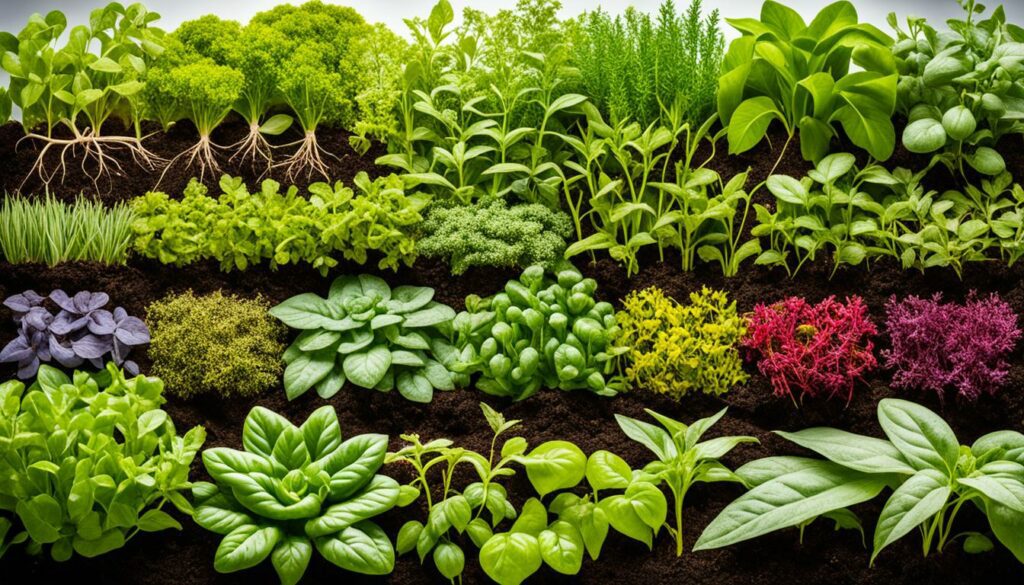
Many groups are working together to promote soil life. The Rodale Institute is one example. It does research on things like composting and soil quality to help farms improve. Collaborations like this are crucial for spreading good soil management.
The Rockey brothers practice regenerative farming to make their soil more diverse. They use techniques like cover crops and avoid disturbing the land too much. This keeps their yields up, while making their land better and cheaper to work on.
Working together for soil health is very important for the long run. Nature & More leads the Save Our Soils campaign to raise awareness about soil’s role. This helps make sure farming is good for the Earth and for business, securing a greener future for farming.
To sum up, boosting soil biodiversity is essential for farming that lasts. By working together and trying new methods, we can improve soil and make farms that can stand the test of time.
The Soil Renaissance Initiative stands out as a key milestone in working together for soil health. It started in 2013. At that time, a group of farmers, experts, and leaders joined forces to tackle major issues in saving and enhancing our soil.
It began because we desperately needed to talk about soil health more. Key people from farming, companies, schools, NGOs, and the government got together. The Soil Health Institute, a group focusing on soil study, steered things with their solid research and guidelines.
The Initiative has always aimed at four key things: knowing what to measure, the money side, new findings, and teaching others. Doing this, it hoped to improve how we work together on soil health. This was achieved by agreeing on how to measure health, learning about its value, telling people about it, and looking into it more deeply.
A big win for the Initiative was getting everyone to talk the same about soil health. They chose the USDA’s definition to bring everyone together. This made it easier for all involved to understand each other.
Another milestone was the ongoing support from The Noble Foundation, dating back to 1945. Their work underscores how vital healthy soil is for food around the world. They boosted teamwork between different farming areas. This led to the spread of eco-friendly methods and new tech to heal the soil.
Also, events like ‘A Dialogue on Food and Agriculture in the 21st Century’ looked into feeding the fast-growing world. By 2050, Earth may have 9 billion people. This initiative showed we’re not just about fixing our soil today. It’s about making a long-lasting difference for our planet’s future.
To sum up, the Initiative truly brought many together for one big cause: to mend our soil. Thanks to great plans and teamwork, it made soil health a top priority in sustainable farming.
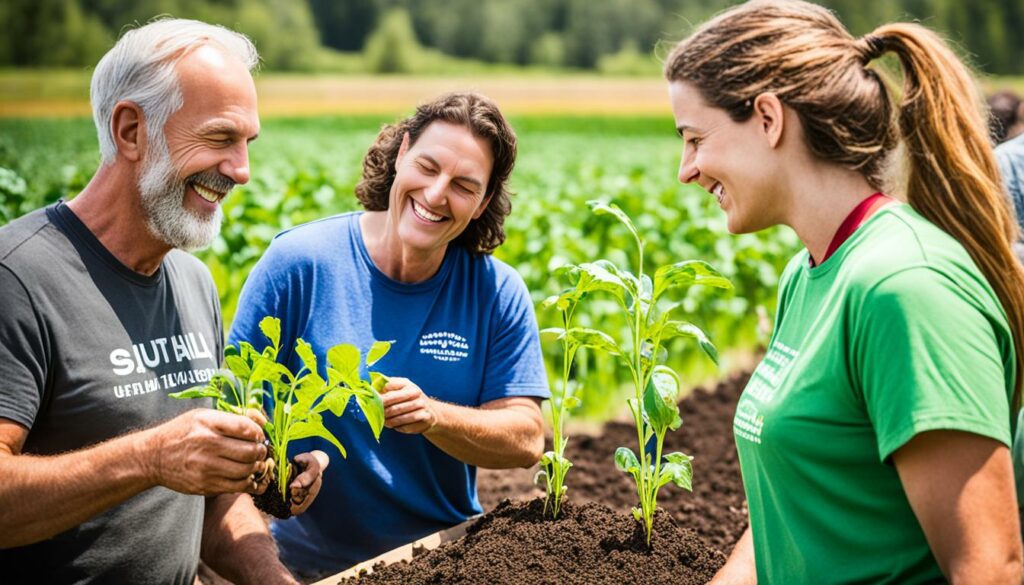
Improving soil health needs us all to work together wisely. We’ll check out ways to share and care for soil that really work. Let’s look at how people have joined forces to take care of our soil well.
Good soil care means using smart plans together. Here are some ways people work together for better soil:
Next, we’ll show how people coming together has made a big difference in looking after soil:
“In Thailand, the Volunteer Soil Doctors program started in 1995. It was thanks to the Government of Thailand. Now, people from different places work together in Thailand to keep its soil healthy. This happened during a big meeting there in February 2024.”
“In Virginia, the NRCS (Natural Resources Conservation Service) is a great example of teams working together for soil health. Since 2013, they’ve been leading the State Soil Health Initiative. Their plan, set in May 2020, shows how they partner with others and come up with new ideas. They’ve done a lot with Virginia Tech, like the project 4TheSoil.”
These are real situations that prove teaming up helps the soil a lot. They show that when we work together, we can make farming better for the long run. This keeps the soil strong for many years to come.
Farmers are crucial in regenerative agriculture. They lead in restoring soil health through new and green methods. By working on their farms, they make our environment better. Their work in soil health is changing farming for the better.
Switching to regenerative farming is tough for many. They worry about making less money at first and the cost of new methods. But, in the long run, the benefits are big. For example, using Soil Health Management Systems can boost farm income and cut costs.
Also, it boosts yields. Many farms see better results. These methods help crops grow better and handle bad weather. They also protect the land from damage and keep it healthy.
Farmers show their smart side in regenerative farming. They use new ways like planting cover crops, not tilling, and changing what they grow. These ways help the soil recover without using as many chemicals.
These new methods bring lots of good things. Farms can deal with wet weather better, and they are more ready for bad times. The soil also gets stronger and holds water, which helps the whole farm stay healthy.
| Crop | Average Cost Reduction (per acre) | Yield Increase Reported | Net Income Increase (per acre) |
|---|---|---|---|
| Corn | $14 | 42% | $65 |
| Soybean | $7 | 32% | $65 |
| Other Crops | $16 | 35% | $65 |
These facts show the good both money and nature get from regenerative farming. By taking care of the soil, farmers help the whole farm thrive in the future. It’s a key part of making farming last for a long time.
Government support is key to making soil strong and helping farms be sustainable. I will talk about how different policies and plans have made big changes in soil health.
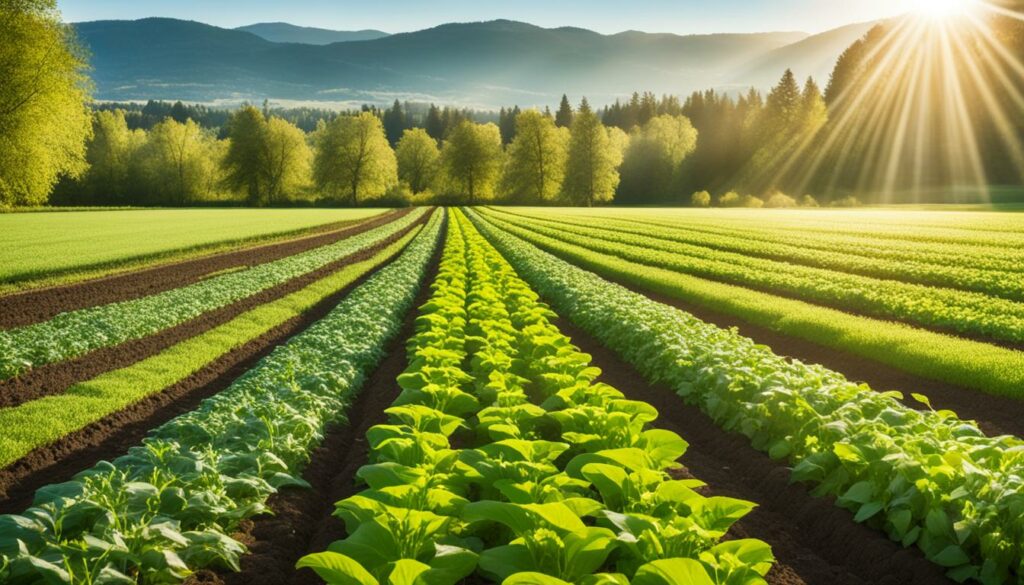
One big step is the Farm Bill. In 2018, it started a special project to save soil and help people make money at the same time. This is part of a broad effort to make sure all soils in the country are healthy. Also, the government put a lot of money into help programs. These include the Environmental Quality Incentive Program ($8.45 billion), Conservation Stewardship Program ($3.5 billion), and Agricultural Conservation Easement Program ($1.4 billion), among others.
Government rules can make soil much better at trapping carbon, which fights climate change. It could lower 4% of the world’s yearly greenhouse gases. The fight against climate change got a big boost when the government supported 141 projects with $3.1 billion in 2022. This shows how strong policies can make big changes. Local governments also do their part by encouraging everyone to look after the soil.
| Program | Funding (in billions) |
|---|---|
| Environmental Quality Incentive Program | $8.45 |
| Conservation Stewardship Program | $3.5 |
| Agricultural Conservation Easement Program | $1.4 |
| Regional Conservation Partnership Program | $4.95 |
| Conservation Technical Assistance Program | $1.0 |
| Partnerships for Climate-Smart Commodities Program | $3.1 |
The farming world is facing a big challenge with weeds becoming resistant to herbicides. This has led to a need for more sustainable weed control methods. These new methods not only require more effort but also increase costs.
In this tough situation, community connections and shared knowledge play a key role. They help in encouraging diverse plants in the soil and improving how we manage the land together.
Cover crops are one important method helping farmers reduce their need for chemicals. Farmers are being very smart and finding ways to use these methods. They are learning from each other, helping all to fight weed resistance and keep soil healthy.
The Soil Renaissance began in 2013, showing that when everyone works together, big changes can happen. All parts of agriculture must unite to move towards more eco-friendly farming. This ensures that these good farming practices are used and continue.
The Advanced Soil Health Training project from the AFT is planning to help more than 20,000 farmers in five years through the SMART Resource Network. This work, backed by Truterra and other groups, aims to give farming help to 7,500 farmers, covering over 7 million acres. It hopes to cut down on greenhouse gas emissions a lot.
The MSHN and PASA’s Soil Health Study show how working together can make a big difference. Farmers from areas like Pennsylvania, Maryland, and Maine check their soil health, join workshops, and get important help and funds. Networks such as OpenTEAM, MSHN, and the New England Grazing Network are also playing a big role. They help improve soil health and make the regional food system stronger.
Working together on soil health is key for the future of farming. It involves farmers, scientists, and government. They share ideas to make the soil better in fields everywhere.
Challenges in soil care include tough weeds and a decrease in healthy soil parts. There’s also soil erosion and fewer plant and animal types. Bad farming and changing weather make these problems worse. So, we must farm in ways that keep soil rich and the environment happy.
Regenerative farming aims to help farmers and the environment. It focuses on less digging in the soil, planting cover crops, and changing which crops grow where. This helps the land bounce back and stay healthy.
Farmers, scientists, and people who make laws are important for healthy soil. Also, charities and local groups help out. They all work together on soil projects and make sure everyone is involved.
Great teams make soil health better by using many ideas and skills. They might include global projects and small local teams. These ways help in many areas, from teaching to making policies for better farming.
Weeds that resist weed killers are hard to fight. They can make it expensive to farm and damage nature. To fight back, farmers share smart ways to grow different crops, add covers to the soil, and pull out weeds by hand.
Teamwork on soil helps create farming that’s good for everyone. It covers big areas and keeps farms healthy. By working together, people can grow food in ways that help the soil get better over time.
In India, for example, a farming plan helps make more crops and protect nature. Africa has a big plan to make farms better for everyone. In Mexico, a project looks after a forest and helps farmers earn more. All these are successful thanks to everyone working together.
Working together shares ways to keep the soil strong and full of life. Projects that mix up crops, don’t dig as much, and add natural things make the soil tougher. This helps the land stay healthy and grow good food.
More life in the soil makes it work better. Bugs and plants help with food growth, battling pests, and handling water. So, farming in a way that’s good for many types of life is also good for the farm and the environment.
The Soil Renaissance makes many people care about soil health. It gets them talking and working on farming that keeps the soil strong. Thanks to its work, soil’s health is now a big focus in making farms better for the future.
Important strategies are using smart farming methods and planting extra crops. They help use fewer chemicals and care for the environment. These methods work well and teach others how to make the soil rich and nature happy.
Farmers lead in making the land and farms better. It’s not easy, but with new ways of farming and sharing what they know, they help the land heal. Their hard work is key to farming that’s good for everyone.
Governments can help farmers use better ways to farm. They do this by giving money for green farming and for learning new things about the land. Their help makes farming kinder to the earth and the food we eat better.
Sharing what works in farming makes everyone better at it. Passing on tips and tricks helps farmers grow good food and look after the land. This way, farming helps the earth keep getting stronger.